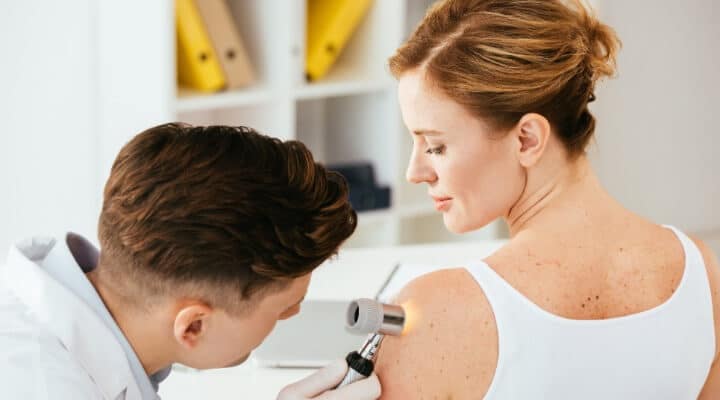Early detection and effective prevention strategies are essential in reducing the impact of skin cancer. Dermatologists play a pivotal role, not only in identifying early signs of skin cancer but also in educating the public about how to protect their skin. Here is how dermatology supports skin cancer awareness through guidance about sun exposure, risk assessments, and early detection of lesions:
Sun Exposure Guidance
Dermatologists may discuss how sun exposure affects skin health. They educate people about changing their behaviors to reduce risks. Ultraviolet (UV) rays from the sun can be harmful, and too much exposure can damage skin cells. Simple habits like wearing protective clothing, using broad-spectrum sunscreen, and staying in the shade during peak sunlight hours can help prevent damage.
For these habits to be effective, consistency is helpful. Dermatologists might suggest understanding how different skin types react to UV rays. People with lighter skin tend to be more sensitive to the sun than those with darker skin. Knowing this can help personalize sun protection methods. People can also learn to check the UV index, which gives daily guidance on safe sun exposure.
Risk Assessments
A key component of dermatology for skin cancer awareness is assessing risk factors for individuals. While genetics, personal medical history, and lifestyle all influence susceptibility, everyone benefits from a tailored assessment approach. For example, those with a family history of skin cancer face elevated risks, requiring frequent monitoring. Individuals working outdoors may accumulate significant sun damage over time.
During a dermatological visit, professionals may evaluate detailed patient histories alongside visual skin examinations. These assessments range from examining moles and birthmarks for irregularities to discussing sun exposure behaviors. Factors like the number and type of moles play a part in determining potential risks. Beyond clinical examinations, dermatologists may share guidance about self-assessment. Knowing how to track changes enables individuals to monitor their own skin health. Early identification followed by timely intervention may significantly influence outcomes.
Identification of Lesions
Dermatologists receive specialized training that enables them to identify suspicious skin lesions accurately. Changes in size, shape, or color of these abnormalities are early signs of skin cancer. Using advanced diagnostic techniques, dermatologists can distinguish between benign and malignant growths. When necessary, they perform biopsies to confirm the nature of a lesion.
The three main types of skin cancer are melanoma, squamous cell carcinoma, and basal cell carcinoma. Each type appears differently. During close examinations, dermatologists focus on identifying unique features of each. They also use various tools to help make more accurate assessments.
While professionals are skilled at detecting abnormalities, individuals also have an important role. Regularly checking their own skin can help catch changes early. It’s especially helpful to examine hard-to-see areas like the back or scalp. A monthly self-check, combined with regular visits to a dermatologist, creates a partnership that enhances awareness and early detection.
Find a Dermatology Clinic
When it comes to protecting your skin, seeking professional support is a practical step. Locating a reputable dermatology clinic in your area makes skin health management accessible. Many clinics offer comprehensive check-ups alongside specialized services, catering to a wide range of needs. Whether scheduling an initial consultation or planning a yearly exam, visiting a licensed dermatologist promotes proactive care. Take the step to prioritize your health by connecting with a professional today. Book an appointment with a dermatologist to receive personalized guidance in managing your skin and addressing any concerns.







